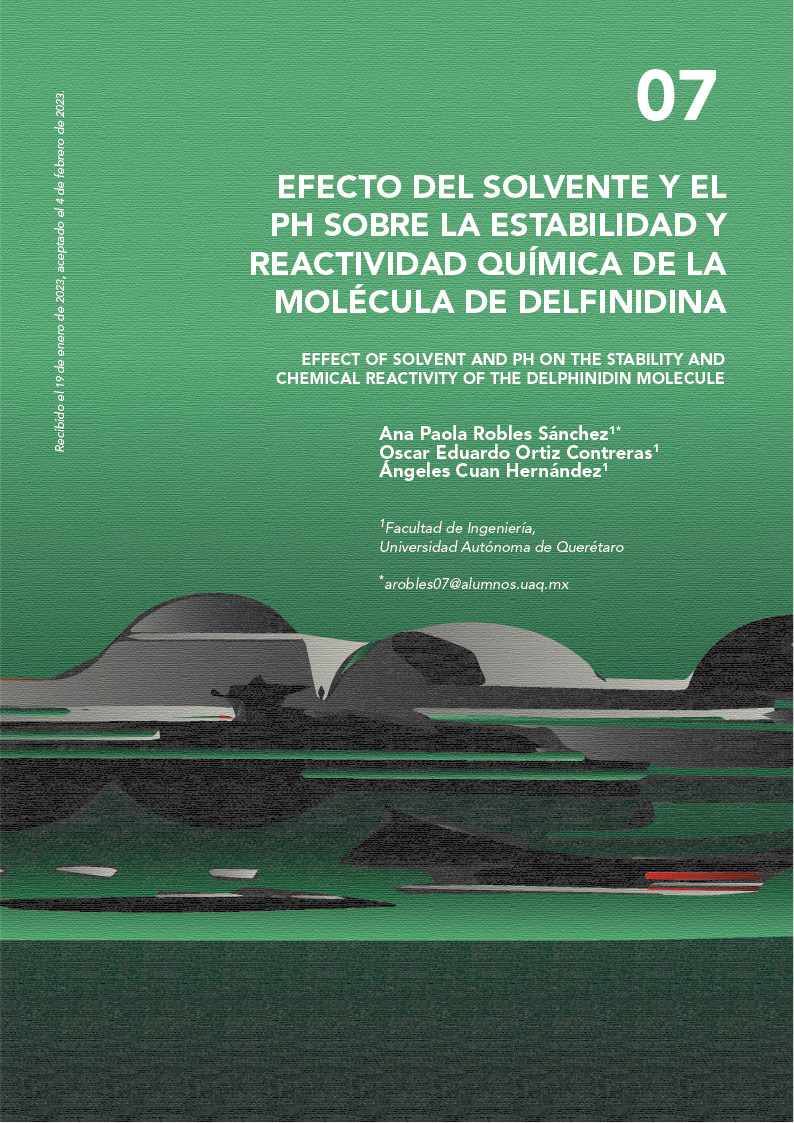Abstract
The study of the stability in different solvents and its effect on the chemical reactivity for the delphinidin molecule is presented, using molecular modeling as a tool. The structural modeling of delphinidin in the different solvents (water, methanol, ethanol and acetone) was carried out based on the predominant structures of delphinidin according to the pH (1, 4.5 and 7). Quantum mechanical studies were performed using density functional theory (DFT) with a B3LYP level and a 6-11+g(d,p) basis set. The solvation energies of the delphinidin molecule were obtained, finding that the molecule dissolves best in methanol. In addition, the chemical reactivity indices for the molecule were obtained due to the effect of the solvent, finding that when it is found in water as a solvent, it acquires a lower hardness, making it more susceptible, that is, more reactive. The results also showed that at pH < 2 using methanol as solvent, the hydrogen atom of the hydroxyl group attached to the 4' carbon is the most likely to donate hydrogens.
References
S. K. Panchal, O. D. John, M. L. Mathai, and L. Brown, “Anthocyanins in chronic diseases: The power of purple,” Nutrients, vol. 14, no. 10, p. 2161, 2022.
H. E. Khoo, A. Azlan, S. T. Tang, and S. M. Lim, “Anthocyanidins and anthocyanins: Colored pigments as food, pharmaceutical ingredients, and the potential health benefits,” Food & Nutrition Research, vol. 61, no. 1, p. 1361779, 2017.
Bendokas, V., Stanys, V., Mažeikienė, I., Trumbeckaite, S., Baniene, R., & Liobikas, J. (2020). Anthocyanins: From the field to the antioxidants in the body. Antioxidants, 9(9), 819. https://doi.org/10.3390/antiox9090819
C. Chaiyasut, B. S. Sivamaruthi, N. Pengkumsri, S. Sirilun, S. Peerajan, K. Chaiyasut, and P. Kesika, “Anthocyanin profile and its antioxidant activity of widely used fruits, vegetables, and flowers in Thailand,” Asian Journal of Pharmaceutical and Clinical Research, vol. 9, no. 6, p. 218, 2016.
J. Liu, H. Zhou, L. Song, Z. Yang, M. Qiu, J. Wang, and S. Shi, “Anthocyanins: Promising natural products with diverse pharmacological activities,” Molecules, vol. 26, no. 13, p. 3807, 2021.
R. Matera, S. Gabbanini, S. Berretti, R. Amorati, G. R. De Nicola, R. Iori, and L. Valgimigli, “Acylated anthocyanins from sprouts of Raphanus sativus CV. sango: Isolation, structure elucidation and antioxidant activity,” Food Chemistry, vol. 166, pp. 397–406, 2015.
O. Dangles and J.-A. Fenger, “The chemical reactivity of anthocyanins and its consequences in food science and Nutrition,” Molecules, vol. 23, no. 8, p. 1970, 2018.
H. E. Khoo, A. Azlan, S. T. Tang, and S. M. Lim, “Anthocyanidins and anthocyanins: Colored pigments as food, pharmaceutical ingredients, and the potential health benefits,” Food & Nutrition Research, vol. 61, no. 1, p. 1361779, 2017.
K. Zhang, L. Yuan, Q. Li, R. Wang, and Z.-Z. Zhang, “Comparison of the anthocyanins composition of five wine-making grape cultivars cultivated in the wujiaqu area of Xinjiang, China,” OENO One, vol. 53, no. 3, 2019.
S. Roy and J.-W. Rhim, “Anthocyanin food colorant and its application in ph-responsive color change indicator films,” Critical Reviews in Food Science and Nutrition, vol. 61, no. 14, pp. 2297–2325, 2020.
A. Houghton, I. Appelhagen, and C. Martin, “Natural blues: Structure meets function in anthocyanins,” Plants, vol. 10, no. 4, p. 726, 2021.
K. Sakata, N. Saito, and T. Honda, “Ab initio study of molecular structures and excited states in anthocyanidins,” Tetrahedron, vol. 62, no. 15, pp. 3721–3731, 2006.
Y.-K. Choong, “Fourier transform infrared and two-dimensional correlation spectroscopy for substance analysis,” Fourier Transforms - High-tech Application and Current Trends, 2017.
A. V. Marenich, C. J. Cramer, and D. G. Truhlar, “Universal solvation model based on solute electron density and on a continuum model of the solvent defined by the bulk dielectric constant and atomic surface tensions,” The Journal of Physical Chemistry B, vol. 113, no. 18, pp. 6378–6396, 2009.
L. Estévez and R. A. Mosquera, “Molecular structure and antioxidant properties of Delphinidin,” The Journal of Physical Chemistry A, vol. 112, no. 42, pp. 10614–10623, 2008.
R. Guzmán, C. Santiago, and M. Sánchez, “A density functional study of antioxidant properties on anthocyanidins,” Journal of Molecular Structure, vol. 935, no. 1-3, pp. 110–114, 2009.
A. C. Kumoro, D. S. Retnowati, and C. S. Budiyati, “Solubility of delphinidin in water and various organic solvents between (298.15 and 343.15) K,” Journal of Chemical & Engineering Data, vol. 55, no. 7, pp. 2603–2606, 2010.
N. Tena, J. Martín, and A. G. Asuero, “State of the art of anthocyanins: Antioxidant activity, sources, bioavailability, and therapeutic effect in human health,” Antioxidants, vol. 9, no. 5, p. 451, 2020.

This work is licensed under a Creative Commons Attribution-NonCommercial-ShareAlike 4.0 International License.
Copyright (c) 2023 Perspectivas de la Ciencia y la Tecnología

